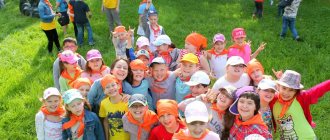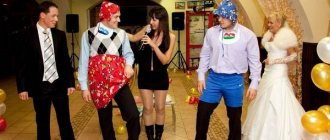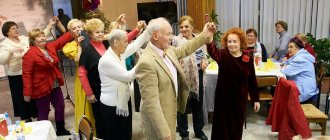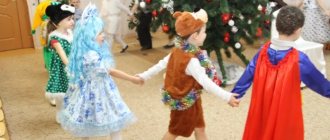Games for children of primary school age are a fun pastime that allows you to quickly get to know each other and unite.
The first time children stay in a summer holiday camp is always aimed at liberating the children and getting to know each other.
- For children of primary school age, gaming competitions in a circle, with songs or poems, are suitable.
- It’s good to have a meeting evening on the first day of the children’s stay at the camp, so that the resulting team can unite and get closer.
- In this article you will find the 10 best games and competitions for initial acquaintance and secondary consolidation of acquaintances for children of junior units.
Game for initial acquaintance and secondary consolidation of acquaintance: “Kaleidoscope of names”
Competition game for getting to know each other
An excellent competitive game that allows kids to get to know each other and remember each other's names. It is often used at children's holiday events and at the beginning of the functioning of holiday camps and other groups.
The counselor first addresses the children with the words:
«To find out your names, I will say the letter. If your name begins with this letter, you must stand up and say your name.”
- The first letter “A” - the kids whose name begins with this letter stand up and say out loud what their names are.
- Continuation - the letter “B” - now the kids whose name begins with this letter stand up and say out loud what their names are.
- It’s the turn of the letter “B” - the children whose name begins with this letter also stand up and say out loud what their names are and so on.
Important: The counselor must ensure that the game takes place at a rhythmic pace, otherwise the kids will become bored.
Game for initial acquaintance: “Say your name and say mine!”
Game-competition for getting to know each other
This competition is great for schoolchildren aged 7 to 12 years old for initial acquaintance.
- The main thing in this competition is to introduce all participants.
- All children sit in a circle with the organizer.
- First, the counselor says his name. Then the next player sitting next to him should introduce himself.
- This is done in a circle: each child says his name and the name of the person sitting next to him.
- If someone forgets names and does not say them, he must quickly get up, run around all the children and return to his place.
At the same time, the counselor says a rhyme:
Counselor's words
While the counselor says these words, the child must run around the circle, return to where he was and say the name of the person sitting next to him and his name. The children find it interesting because they try to remember the name so as not to run around, and they remember well the names of other children in the squad.
Dating games at camp for children from 9 to 12 years old
Dating games for schoolchildren
1. Snowball All participants sit in a circle and take turns calling names and an object, favorite food (with the first letter of their name) or make a movement. And the next participant must repeat the previous one and name his own. 2. Hat Participants stand in a circle. Everyone together makes two claps, a snap of the fingers of the right hand, a snap of the fingers of the left hand, two claps, etc. It is advisable for the counselor to start. So, when clicking the fingers of the right and left hands, the presenter says his name, then two claps, after that, when he clicks the fingers of his right hand, he says his name, and when he clicks the fingers of his left hand, he says the name of one of the participants. The player whose name was called repeats the same thing. For example: Olya, Olya, two claps, Olya, Igor, two claps, Igor, Igor, two claps, Igor, Sveta, etc. Those who didn’t have time “slapped.” 3. Thrush Participants form two circles - internal and external, equal in number. The players in the inner circle turn their backs to the center and pairs are formed. Then, together with the presenter, they say: “I am a blackbird, you are a blackbird, I have a nose and you have a nose, I have scarlet cheeks and you have scarlet cheeks.” You and I are two friends. We love each other." At the same time, couples perform movements: with an open palm they point at themselves and their neighbor, touch their fingertips to their nose and the neighbor’s nose, to their cheeks, hug or shake hands, saying their names. Then the outer circle takes a step to the right, and new pairs are formed, the game continues. 4. Paper accordion Sheets of paper of the same size are distributed. The sheets are asked not to be crumpled, but folded, folded into strips as many times as possible (like an accordion). You can bend sheets with both hands. After the task is completed, the facilitator asks each participant to tell about themselves. Moreover, after each biographical fact, one or another “harmony” strip is folded back. The winner is the team whose “biographies” are more interesting and varied. So “paper accordions” will help the children get to know each other better 5. Encrypted note Each participant takes a piece of paper and a pen. The presenter gives a task for everyone: write down your favorite color, favorite animal, favorite group, favorite activity. After writing, all notes are put into a hat/box. Then everyone takes out a note of any color except their own, reads it and tries to guess who its author is. He approaches this man and puts his hand on his shoulder. If he guessed right, then that person must prove that it is his note. 6. ARAM-SHIM-SHIM In the center of the circle stands the driver with his eyes closed and his arm outstretched. The others begin to dance around him, loudly saying (the driver spins in one place in the opposite direction): “Aram-shim-shim, Aram-shim-shim, Aramia-Zulfiya, look at me!” The circle and the driver immediately stop at the end of the words. The one to whom the driver's hand points leaves the circle. This must be a person of the opposite sex. (If suddenly the hand stops on a person of the same sex, then you need to look clockwise to the first suitable one). The driver and the chosen one stand with their backs close to each other. The circle begins to count: “And - one, and - two, and - three!” At the count of “Three,” both sharply turn their heads in the direction they have chosen. If, as a result of this, the faces of the driver and the chosen one are turned in the same direction, then they kiss. If the faces are facing in different directions (for example, both turned their heads to the left), then the driver and the chosen one shake hands. The leader gets into a round dance, the chosen one becomes the leader, the game starts over. 7. GUESS WHOSE VOICE The driver moves aside while the players agree on who will cast the vote. Then the driver stands in a circle and closes his eyes. The players walk in a circle with the words: “We gathered together in a circle, suddenly turned around at once, and when we say “Jump, skok, skok” (these words are pronounced by one person), guess whose voice it is.” The driver opens his eyes and guesses which of the guys said “Skok, skok, skok.” If he succeeds, he changes places with the speaker. You can give the driver three attempts. If he still doesn't guess, the game starts over. 8. “Gather in groups by name and shout out your name in chorus.” People with unique names are united in one group and must shout something that unites them. 9. “5 important things.” Performed in pairs. Couples separate for five minutes and silently show each other the five most important things to each other. And then the couple introduces each other to the circle with gestures. Possible options: the five most terrible things for me, the most unpleasant, etc. 10. “Tell about yourself in three words.” 11. "Newspaper". The group stands in a circle. The presenter is in the center, he has a folded “newspaper” in his hands. The name of someone from the circle is called, and the presenter tries to insult him with a newspaper. In order not to be insulted, the person named must quickly name someone else standing in the circle. If a person is insulted before he says his name, he becomes the driver. After some time, an additional rule is introduced: the former leader, as soon as he stands in the circle, must quickly name a name. And if he doesn’t manage to do this before the new leader insults him, he becomes the leader again. In a group in which there are many unfamiliar people, it is sometimes advisable for the person whose name was called to raise his hand, since the leader may not be familiar with names. 12. “Introduce yourself in different ways.” Each person in the circle must “introduce himself”: make a gesture, say a word, read a poem, etc. 13. “Ball in a circle.” Everyone sits in a circle. The first player has the ball in his hands. He calls someone's name and throws a ball to that person. The person who catches the ball must say another name and throw the ball to him. This continues until the entire circle has been walked around, and the ball should be in everyone’s possession only once. 14. "Cards". The group is given cards divided into squares. Each square contains some quality of a person. (For example: I like to sing. I have a dog. I am sad. Etc.) Everyone must find people with these characteristics and write their names on their card so that all the cells are filled. The exercise should include those qualities that are important to the teacher: interest in specialized activities (I love theater), hobby groups (I like to read science fiction), qualities unique to the participant whom you want to “win” as part of the exercise (written for a specific person) . Several guys stand in a line and tell the driver their names. Then the driver turns away, the participants change places and the driver must correctly call them by name. 15. “Shake hands with as many people as possible.” Everyone must have time to shake hands with the maximum number of people within a certain time (1-3 minutes). The attention of the participants is fixed on the fact that they should shake hands in a friendly manner, looking into the person’s eyes. Option: be sure to give your name. You can stipulate that you need to count the number of people with whom you said hello. Then, at the end of the exercise, the presenter asks: “Who said hello to more than 10 people? And more than 20? A few of the best are revealed. 16. I WILL TAKE WITH ME ON A HIKE... The game is played in the same way as “Snowball”, but in addition to his name, each player also names an object that he would take with him on a hike (or anywhere) and which begins with the first letter his name. 17. I NEVER... Everyone sits in a circle and puts their hands on their knees. The first player says something he has never done in his life. For example, he says: “I have never flown on an airplane.” If one of the players was flying, then he bends one finger on his hand. Then the next player speaks, and so on. round. The winner is the one who bends all his fingers the fastest. 18 . Nobody knows that I….. So the players pass each other a soft toy or something like that. And the phrase of the person who happens to have the toy begins his speech with the words “Nobody knows that I.....” And names his hobbies or what he used to do 19. “A person who has something like me” On pre-prepared pieces of paper with signs children need to collect signatures from children who have something like him (eye color, hair, height, etc.) 20. Don’t yawn. There is a basin of water in the center. People sitting in a circle pass boxes. Whoever has the box lights a match and while it is burning, he must talk about himself. Throw the burning match into a bowl of water. 21. Original acquaintance. Everyone should introduce themselves, for example, like this: “My name is Masha, but in fact I am a terrible phantom!” 22. Trolleybus. There is 1 free chair in the circle. Participants change seats in a circle with the words: And I’m going (1st) And I too (2nd) And I’m a hare (3rd) “Hare” must name the participant who will take the empty chair. 23. Molecules Everything is atoms and moves around the room. The presenter announces how many atoms there should be in a molecule and the children unite. You can give an additional task to microgroups Get to know each other Give a compliment to a neighbor with the right Say your mood. 24. Shootout Everyone walks chaotically around the room with their heads down. If you meet someone's legs, you quickly raise your head and get to know the person. And the game continues. 25. Hot chair Everyone is divided into pairs. For 5 minutes they talk to each other about themselves, and then everyone introduces their partner, standing behind him. 26. Sweet bag Everyone sits in a circle. In the center is a bag of candies. The first participant takes the candy and unwraps it with the words “I love...” When all the participants have spoken, we return the candy wrappers to the bag with the words “I don’t like...” 27. Self-portrait Each group member draws himself and his hobbies on a piece of paper. Then all self-portraits are mixed and taken out 1 at a time. The players’ task is to guess whose portrait it is. 28. Marriage announcement. Each participant writes a marriage announcement. Then all the advertisements are mixed and taken out 1 at a time. The players’ task is to guess whose advertisement it is. 29. Dominoes Right palm “I love...” Left palm “I don’t love...” 30. Name starting with 3. Children take turns saying the numbers, and for numbers that are multiples of 3 or ending in 3, they say their name.
We recommend watching:
Competitive game program for younger schoolchildren “12 months” Entertainment for children in a summer camp Games in a summer health camp Games with the hall
Similar articles:
Dating games. Games for children's camp
Counselor's piggy bank
Dating games for children
Summer camp games
Games in the camp
Game for secondary consolidation of acquaintances: “Black Cat”
A competition game for getting to know each other.
To conduct this competition, you need to prepare in advance: make a cat mask and a small frame with fabric in the form of a screen. You can use some kind of stand or wall.
Children should stand in a circle. One baby is hidden behind a cat mask and placed behind a wall or small screen so that he will not be recognized by his clothes or external signs.
Leader says:
"Find me a cat".
All the children turn around and try to find out who is not in their circle. The counselor repeats again:
Counselor's words
Whoever understands who the missing person is says the name. If you can’t remember, then all together, at the command of the leader, you need to say the following words:
Black cat, black cat, We scream, and he sings.
The cat must say any word or meow. Now the children guess the child by his voice and say his name. When the name is called correctly, the cat comes out and takes off the mask. Then another child is chosen and the game is repeated.
Tip: To make it more interesting, you can make several cats. In this case, you will have to draw more masks and build screens to hide children wearing masks behind them.
Game for secondary consolidation of acquaintances: “I am a princess”
A competition game for getting to know each other.
This fun competition will help you not only get to know each other, but also have fun. The kids will not be called by their own names, but by heroes from fairy tales, cartoons or films. Thanks to this game, children will become closer to each other and can have a lot of fun.
- Everyone needs to stand in a circle and come up with the name of a famous character from a cartoon or fairy tale: Don Quixote, Princess, Beast, and so on.
- At the same time, you need to think about what movement needs to be performed so that it characterizes this character. For example, the Princess curtsies, the Beast makes a scary face, and so on.
- Now the game begins: the first player showed who he is, the second must repeat the actions of the first and guess who he is.
- You can make a mistake in guessing the character, but the gesture must be repeated correctly.
- If someone makes a mistake and incorrectly repeats the neighbor's grimace, then the chain begins again.
No names were spoken in this game, but the children rallied together and had a lot of fun.
Download material
so UNT / To help the counselor / Games camp
dating games
07.09.2011 9382 814
Game "Five Names"
Two players, a boy and a girl (these can be representatives of two teams) stand at the end of the aisles between the rows of desks. At the leader’s signal, each of them in turn must walk five steps forward. At every step, without hesitation, they pronounce the names of the guys from the class (boys are the names of girls, girls are the names of boys).
Game "Guess five times"
Each participant has a card with a word attached to their back, which they cannot see. The player finds an “interlocutor”, reads his word, and the “interlocutor” does the same. To guess their word, they ask each other five questions that can only be answered “yes” or “no.” If the words are not guessed, new pairs are formed and again five questions.
Important: when the word is guessed, everyone writes their name on a card and attaches it to the front.
Game “We are walking in a circle with you”
All players stand in two circles, one inside the other. Those standing in the inner circle turn to the right, those in the outer circle - to the left.
Moving in a circle, participants say the following words:
You and I walk in a circle, Let's look into each other's eyes, We freeze for a minute - We remember the names:
At the words “...we freeze for a minute,” the participants stop, and when the chant is over, they shake hands with the person opposite whom they stopped, saying their name, etc.
Game “A Wizard Came to Us”
Participants are given pens and paper. They are given the following situation: “A wizard has come to you. He can fulfill your seven wishes, which you must write on pieces of paper, starting with the words “I want.”
Within three minutes, participants write down their wishes on paper.
Game options:
· As a game option, you can invite a group of participants to identify 7 common desires from all those expressed.
Game "Name and Fruit"
A dating game, but fun anyway. Everyone sits in a circle. The first player introduces himself (for example, Misha) and names his favorite fruit starting with the first letter of his name (“My name is Misha, I love tangerines”). His neighbor repeats, “Misha loves tangerines,” and also introduces himself and says his favorite fruit, etc. in a circle until everyone remembers each other.
Game "Goat"
All participants stand in a circle, join hands and walk in a circle in a round dance. In the center of the circle is the game leader. He chooses a mate from the circle under the words:
The goat walked through the forest, through the forest, through the forest. I found myself a princess, princess, princess.
A pair of participants in the center of the circle performs actions, illustrating what the participants standing in the circle are reciting.
Come on, goat, let's jump, jump, jump. And we kick our legs, we kick, we kick. And let's clap our hands, clap our hands, clap our hands. And we stomp our feet, stomp, stomp. Come on, let's spin around, spin around, spin around. And we'll be friends forever, we'll be friends, we'll be friends.
After meeting, the couple separates and both participants choose a new partner. Now there are two pairs in the circle. And so on until all the pairs stand in a circle.
Game "Hello"
All participants stand in a circle facing shoulder to shoulder. The driver walks along the outside of the circle and touches one of the players. The driver and the player who was hit run in different directions along the outside of the circle. Having met, they shake hands, say “Hello” and say their names. Then they run further, trying to take an empty place in the circle. The one who is left without a place becomes the driver.
Game "Interview"
All participants sit down or stand in a circle. At the command of the leader, the players count on the first or second and form pairs. The first one interviews the second participant on the right, and he himself gives an interview to the second participant on the left. Then, all participants in a circle talk about their neighbors, calling them by name.
Game options:
· Game “We are alike and not alike.” After a five-minute interview, the participants take turns talking about themselves, starting their speech with the words “We are alike:”. In the next round, the key phrase with which the participants will begin their speech is “We are not alike:”
Game "Lemon-lemon-lemon"
Everyone sits in a circle, the leader is in the center. He points to someone sitting and says: “On the left (right)!...lemon-lemon-lemon.” While he is casting this spell, he must have time to name the neighbor on the left (right). Anyone who makes a mistake or does not have time is temporarily eliminated from the game.
Neighbors are changing, we need to quickly adapt.
Game "General Quality"
All players sit or stand in a circle. One of them, the presenter, does not have enough space. It is called some quality that several players have. They must change places with each other.
For example: Swap those with dark hair. All dark-haired participants change places. At the moment of changing seats, the presenter tries to take an empty seat. If he succeeds, his role goes to the player who did not have enough space.
When the leader says the phrase “General quality,” all players must change places.
Game options:
· Game "Fruit Salad". Each participant receives a card with a picture of one of the fruits (pear, apple, plum, etc.). Next, the game is similar to the previous one, only instead of the phrase “General quality” the presenter says “Fruit salad”.
Game "Radio Station"
All participants sit down or stand in a circle. The leader sets the rhythm of completing the task - two claps, two swings with arms bent at the elbows and with clenched fists. Whoever is comfortable can raise their thumb.
Two claps are given for consideration, and for each movement of the hands, the participant says his name twice. During the transmission of the “radiogram”, the participant states his name and the name of the person to whom he transfers the right to play the game.
For example: cotton-cotton SEREZHA-SEREZHA, cotton-cotton SEREZHA-SEREZHA, cotton-cotton SEREZHA-NATASHA, cotton-cotton NATASHA-NATASHA, etc.
As you probably already guessed, the player who receives the “radiogram” first says the name of the one who transmitted the “radiogram”, and then his own. And so on.
If the participant receiving the “radiogram” hesitates or makes a mistake, you can take a “forfeit” from him, but that’s a different game.
Game "Snowball"
All participants in the game sit down or stand in a circle, so that all players can see each other. Participants take turns saying their name. Each subsequent player names the names of all previous players adding his own to them. For example: the first participant says his name, the second - the name of the first and his, the third - the name of the first, the name of the second and his, and so on until the last player, who must name the names of everyone in the circle.
Game options:
- In addition to his name, each player names a quality that begins with the first letter of his name and corresponds to his character.
For example: Vera - loyalty, Sergei - brave, Natalya - tender...
- Each player, calling his name, accompanies it with some kind of gesture.
- Each player, calling his name, enters the circle of players, making some kind of movement - waving his hand, limping, bowing, etc. Following him, all the players take a step into the circle, calling the name of the previous player and repeating his movement.
Tips for organizers:
When carrying out all variants of the “Snowball”, be sure to change or rearrange the players each time, this helps to remember more names.
Use the Overall Quality game to move players. After swapping participants several times, you can use another version of the “Snowball”, etc.
Game “I do not tolerate / I appreciate”
All players sit in a circle. Each participant takes turns talking about himself, starting his story with the phrase “I can’t stand:” The key phrase of the next circle is “I appreciate:”
Anyone can say “I miss” or “there is nothing I don’t tolerate/appreciate.” Please note that participants should not comment on what others are saying either before or after the exercise.
Game "Vanity of Vanities"
All participants in the game are given cards, which are divided into 9-25 cells. Each cell contains a task. The essence of the game is to write down in each cell the name of a person who (here there is room for your imagination) loves fish, keeps a dog at home, goes hiking, etc. The more unexpected the tasks, the better.
Using this game, you will not only introduce the players, but will also be able to carry out an initial diagnosis - it all depends on what questions you write down in the task cells. You can identify lovers of drawing, singing, and playing the guitar.
There is no winner in this game, although you can mark those who complete the task first.
Game "Guess whose voice?"
All participants stand in a circle. The driver steps aside while the participants agree on who will vote. Then the driver stands in a circle and closes his eyes. The players walk in a circle saying:
We gathered together in a circle, We suddenly turned around at once, And as we say, “Leap, hop, hop (these words are pronounced by one person), Guess whose voice it is.
The driver opens his eyes and tries to guess which of the participants said “Jump, skok, skok.” If he succeeds, he changes places with the speaker. You can give the presenter several attempts. If he still doesn't guess, the game starts over.
Game "Grandfather the Merman"
All participants stand in a circle. The driver sits in a circle with his eyes closed. The players move in a circle saying:
Grandfather Vodyanoy, Why are you sitting under the water, Look out for a little bit, Just for a minute.
The circle stops. The “water man” gets up and, without opening his eyes, approaches one of the participants in the game. His task is to determine who is in front of him. If the “merman” guessed right, they change roles, and now the one whose name was named becomes the driver.
See the downloadable file for the full text of the material.
The page contains only a fragment of the material.
Game for initial acquaintance: “Snowball”
A competition game for getting to know each other.
This game helps children of junior units get to know each other.
- The counselor starts the game by calling his name.
- A child sitting or standing nearby says the name of the counselor and his name.
- The child standing next to him already names three names along with his own. This continues until all the children have said the names of others and their own name.
- At the same time, you need to make sure that the guys do not simply repeat names, like parrots, and the counselor should focus specifically on remembering the person, adding with each new name pronounced a small characteristic of appearance: “This is our smiling Ilya” or “Sveta with interesting hairpins.” and so on.
The counselor should be the last to say the names of all the kids, thereby showing that it’s easy to remember everyone’s name.
For the counselor: 5 games to get children to know each other
First, the distribution: the lists are read out, first squad No. 1, then 2... You hear your name, go up to the counselors - these smiling, slightly nervous, but very handsome girls and guys in ties. We go to the building, the children drag bags up the stairs to the second floor, we choose rooms. Meeting our neighbors, unpacking our things. Knock...
— In 10 minutes we’ll all gather in the hall of our floor. Don't be late!
Before becoming a camp counselor myself, I came to the Moscow region almost every summer, once visited Artek and several times in Yevpatoria, in the famous Brigantine in those days. We played games, set rules, held evening candles, went to the dining room together, won competitions and identified actors, musicians, artists and other various talents. But only after going through the School of Leaders, I learned the behind-the-scenes details of organizing this entire process. It turns out that children don’t just play, everything is thought out and planned, but the counselor is also a subtle psychologist and leader.
Now, while preparing the DreamCatchers Camp, I remember different stories, and I wanted to share my best practices and useful tips.
In the first days of the shift, it is important to interest and captivate children with interesting activities. All efforts are aimed at getting to know each other, uniting children with each other, identifying leaders, searching for the talents and abilities of children, so that they become not just a group, but a squad. The counselors try to charm the children, become an example for them and reveal their secrets and share stories.
The faster the guys get to know each other, the easier it is to work with them. One of the simplest forms of dating is a game. All activities are selected according to the goals that stand on certain days of the shift.
Very important for the selected games is:
- criterion “number of participants”, since some games require a number of participants of at least 20 people, while others are not recommended to be played in groups of more than 14 participants;
- the criterion is “game time”, because there are games that can take a long time (15-20 minutes). In this case, the group begins to lose momentum, and additional efforts will be required to correct the situation;
- criterion "success". The group must successfully complete the game, since for a newly created team it is important to quickly obtain positive results, and the reverse process can lead participants to the idea of joint failure and attempts to find someone to blame for common failures.
Getting to know each other games are games that you can use to get to know guys and introduce them to each other. Conventionally, they can be divided into two groups.
- The first are those that make it possible to learn and remember names. They are useful not only for children, but also for counselors: every child is pleased to know that he is remembered, respected and addressed by name.
- The second are games that help you get to know each other better. During them, we learn the interests, hobbies, abilities and some character traits of the participants. Notice the characteristics of the children in your squad: this will help in the further organization of the camp for participation in various competitions and events.
1. Snowball
The most famous dating game will help you quickly remember all the names and identify guys with a good memory.
The presenter says his name. The next player says the leader's name and his own name. The third player calls the names of the previous ones and his own, and so on in a circle. The most difficult thing will be for the last player - he will have to name the names of everyone present. It's convenient to play in a circle, sitting or standing - it's up to you. One counselor starts, the second one finishes.
There are several variations and complications:
- name the name and characteristic starting with the first letter of the name (Petya the Singing, Vanya the Magnificent, Sasha the Funny): epithets that children come up with about themselves help to understand their attitude towards themselves and their skills;
- name a name and show your gesture or movement: this helps to better remember names and diversify the game;
— we name the name and association: the superhero I want to be like, my favorite book, animal, plant, country, etc.
- name and gait: the children’s task is to copy the player’s gait;
- name and how I can be useful if I find myself on a desert island, etc.
Five important things
Performed in pairs. Couples separate for five minutes and silently show each other the five most important things to each other. And then the couple introduces each other to the circle. Each participant must talk about his partner in the first person.
Possible options: the five most terrible things for me, the most unpleasant, etc. After one round, children can change partners. For example, you played 4 rounds: one player has 4 people about whom he learned several important facts. He talks about one of his partners without mentioning his name, and everyone else must guess who they are talking about.
Line up
The guys need to line up according to a certain characteristic within a certain time (or as quickly as possible). It could be:
- by height;
— by date of birth (day, month, year, full date);
- by hair and eye color;
- according to the length of the hairstyle;
— alphabetically (first letter of first name, last name)
- by temperament, mood, sociability, etc.
Choose any sign and ask the guys to line up, quickly changing the base for the formation. Often children have a natural question: “Where should we build from?” It is advisable not to give an answer - to remain silent or pretend that you do not hear the question.
The game helps to mark the leader, the one who will take the initiative in the formation, i.e., will begin to arrange things “as they should”; in fact, these are, perhaps, those people who can take the initiative in a difficult situation. “Mute” (everyone is silent) and “blind” (with their eyes closed) can also build. This will make things more difficult. As a rule, desperate, brave, energetic, determined people take on this task. Thus, in the game you can check whether potential leaders coincide with formal ones.
4. Blanket
Participants are divided into two teams, located opposite each other. A blanket is pulled between them. On both sides of the blanket there is a chair. From each team, one person sits closer to the blanket. As soon as the blanket is lowered, you must have time to say the name of the person sitting opposite you. Whoever names it faster takes the player to his team. The winner is the team that “draws” more players to itself, that is, the team that knows more names.
5. My name is and I love.
Each person alternately says two phrases: “My name is...” and “I love myself because...”. Don't get distracted by arguments and discussions about your desires. Just say them one by one, impartially and quickly.
It is better to spend the second or third day in the detachment to refresh your memory of names, as well as to get to know each other more closely.
Getting to know each other games should be played in the first 3 days. Then you can move on to games for unity and trust, removing tactile barriers. Through play, children relax, learn and learn a lot about themselves. It is important not only to clearly explain the rules and instructions at the beginning, but also to provide a brief summary and analysis at the end so that the children can reflect on what happened.
Game for initial acquaintance: “Girls-Boys”
A competition game to get to know each other.
Children sit opposite each other on benches or chairs. Girls sit in one row and boys in the other. First, boys say any girl's names. If there are girls with that name, then they should stand up and tell the following information about themselves: what region they came from, what class they study in, and so on. Then the girls call boys' names. The competition continues until the names of all children are named.
Game for initial acquaintance: “Acquaintance for a while”
Game-competition for getting to know each other
All participants gather for a dating evening. The counselor first explains the rules of the game, and then marks the minute on the stopwatch. Children need to get to know as many children as possible in a certain amount of time, shaking everyone’s hand. When the time runs out, the counselor says “Everyone, stop” and the acquaintances stop. Now each child in turn must say how many people he has met, calling names and pointing to the person whose name is called.
Game-competition for initial acquaintance: “Building”
In one minute, while listening to music, children need to line up one after another in alphabetical order of names. For example: Arkady will stand first, Borya will stand second, Varya will stand third, and so on. The counselor must check the correctness of the construction. This will encourage the children to say their names again.
These games will help children not only get to know each other, but also get used to each other and unite. After such an evening of acquaintances, they will stop being shy and will find their friends with whom they will have a great camp shift and will not want to say goodbye when the time comes to go home.
Training “Getting Acquainted” 1
Goals: learn effective, harmonious interaction in a study group, develop communication skills, create a positive microclimate in the group.
Tasks:
- acquaintance with the laws of training;
- getting to know the participants in more detail, creating interest in the training;
- raising positive emotions through playful interaction with oneself and others.
Introductory part
The work begins with a story about what training is and the announcement of its laws.
Training is a bright, emotionally intense activity aimed at changing and harmonizing an individual’s communication style, instilling desired skills and resolving contradictions that manifest themselves in interaction with other people or are of an intrapersonal nature.
Basic laws of training:
1. Law 0:0 All training participants arrive on time at the beginning of the lesson and after breaks, at a pre-agreed time.
2. The law of the microphone. The one with the microphone in his hands speaks.
3. Law of activity. It reads: “You have the right not to participate in any exercise. This does not mean that someone cannot complete the task, it means that the person simply wants to observe from the sidelines. Let the group know your intention in advance. But it should be taken into account: if at least one participant drops out of the group’s work, this affects the work of the entire group.”
4. The law “I am statements.” This law requires you to express your point of view only in the first person: “I believe, I feel, I think...”
5. The law of tactful and friendly attitude towards all group members. “Everyone has advantages and disadvantages. During training, you must be tolerant of other people's characteristics. If you are not satisfied with something, please inform the training leader in the correct form so as not to offend or offend any of the participants.”
6. The law of the name. If the training participants are not known to the trainer or a group of people who are unfamiliar to each other has gathered, then the law is used, formulated as follows: state your name before each statement.
7. Law of politeness. The group is recommended to call all participants by their desired name, which, when introducing themselves, the training participants voice themselves.
8. Law “Here and Now”. It means that everything that happens in the present time and place, as well as the feelings, emotions and attitudes of those present, should be considered within the framework of the training and not transferred to other realities of your life.
9. Confidentiality law. “Everything that happens at this training remains here, and is not discussed with any of the people who did not participate in the training.”
10. The law of offering participants only themselves. We do not invite anyone to participate in the exercise except ourselves.
Main part
Exercise “My historical character”
Goal: acquaintance, self-expression using metaphorical means.
Conduct: each participant comes up with his own historical character. Describes his personality, character, what he is remembered for, his merits, the time and era in which he lived.
Exercise "Interview"
Goal: developing the ability to feel another, to transform into him.
Conduct: participants must divide into pairs, face each other and take turns learning as much as possible about each other in one minute. The participant’s task is to tell on his own behalf everything that he remembers about his partner. After talking about your interlocutor on their own behalf, the rest of the training participants can ask him additional questions, addressing him by the name of his partner.
The following discussion involves answering the following questions: How did you feel more comfortable when listening to yourself or speaking for someone else? Do you agree with the other person's image of you?
Exercise "Let's fight back..."
Goal: equalization of the emotional background and unity of the group.
Conduct: all participants stand in a circle. The presenter names fears and dangers. If one of the participants is afraid of what was voiced by the presenter, then he should stand in a circle. If the rest of the participants remaining in the circle hold hands within 5 seconds (as if protecting those who entered the circle) and loudly and unanimously say: “Let’s fight back...”, then the exercise is considered to have been completed correctly and those remaining in the circle are protected . The main criteria for this exercise are speed, loudness and friendly defense. The presenter’s phrases begin with the following expression: “We were attacked...” The participants’ answer begins with the phrase: “Let’s fight back...”
Exercise “Inflatable doll”
Goal: overcoming stiffness and tension, training muscle relaxation.
Conduct: The leader plays the role of a “pump”: he makes movements with his hands that imitate the operation of a pump. The group members first sit relaxed on chairs, their heads are lowered, their arms hang limply along their bodies. With each movement of the “pump”, the “rubber dolls” begin to “inflate”: the participants straighten up, raise their heads, tense their arms and eventually stand up to their full height, arms outstretched and legs apart. After a few seconds, the presenter “pulls out the plug” from the “doll”, and the players relax and hiss and gradually squat down. The game can be played two or three times. It does not require discussion.
Final part and reflection
Exercise “Magic Shop”
Goal: personal development and reflection, increasing self-esteem and self-confidence.
Conduct: Ask group members to imagine that there is a shop in which there are very interesting “things”: patience, forbearance, goodwill towards others, a sense of humor, sensitivity. trust, self-control, goodwill, a tendency not to judge others, the ability to listen, curiosity, the ability to empathize. One of the participants is called. He acquires one or more “things” that he does not have and in return shares those that he has developed.
The next exercise involves deep reflection. The participants were immediately asked to speak about whether they liked/didn’t like the training, what worked/didn’t work out.










